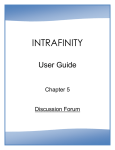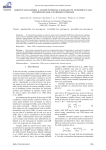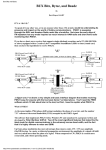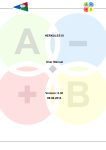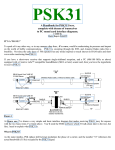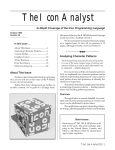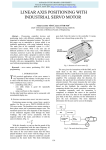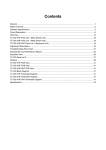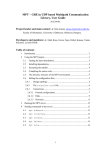Download Slides
Transcript
Introduction to Introduction to programming Imre Varga University of Debrecen, Faculty of Informatics For internal use only! 04 May 2014 General informations Teacher: Dr. Varga, Imre University of Debrecen Faculty of Informatics Depertment of Informatics Systems and Networks email: [email protected] www: irh.inf.unideb.hu/user/vargai room: IF13 (building of Faculty of Informatics) 2 General informations Requirements, conditions: Maximum number of absences is 3. Maximum late from classes is 20 minutes. More than 20 minutes late means absent from class. There will be two tests during the semester. There is only one chance to retake!!! Activity during class means plus score. Furter readings: Adrian Kingsley-Hughes: Beginning Programming, Wiley, 2005. Metrowerks CodeWarrior: Principles of Programming 3 Topics • What are the basics of Informatics? • How does a computer built up? • How does a computer work? • What is software, application, program? • How to describe problems and its solution? • What is algorithmic thinking? • What does ‘program writing’ mean? • Many more things… 4 Computer systems Computer System root User programmer display Windows Hardware processor Software Firefox 6 Computer architecture (hardware) ALU Registers RAM CPU Cache CU AU Bus system Memory ROM I/O interface System Unit Peripherials Keyboard Monitor HDD Mouse CD/DVD Network … 7 System Unit Central Processing Unit (CPU): The brain of computers Memory: Contains datas and instructions Input-Output Interface: Surface between computer and outer world Bus system: Connects together 8 Central Processing Unit Control Unit (CU): Says what to do, controls the parts of the CPU Arithmetic Logic Unit (ALU): Performs operations, does calculations Registers: Some tinny but very fast memory Cache: small, but fast memory Addressing Unit (AU): Deals with memory addresses at read/write operation 9 Memory Random Access Memory (RAM): Readable-writeable operative memory Read Only Memory (ROM) Not rewritable (eg. BIOS-ROM) Increasing size Decreasing speed Memory hierarchy: • Register • Cache • Memory • Hard-disk drive (HDD) 10 Bus system Connects the CPU, the Memory and the I/O interfaces Data bus: Transports the datas from/to CPU Address bus: Contains memory address of reading/writing Control bus: Carries control informations 11 Input--Output Interfaces Input It makes the system accessible to periferials (world) Connection to • Input devices • Output devices • Storage devices • Network devices printer network mouse microphone speaker keyboard monitor projector USB drive 12 Peripherials Input • Keyboard • Mouse • Scanner Output • Monitor • Printer • Projektor Storage • Winchester (HDD) • CD/DVD/Blu-ray drive • USB drive • Memory Card Network • Ethernet • Wi-Fi Other 13 Software User Office application User interface Applications, user programs Database Program Web management development Browser Software Operating system File Memory management management Device drivers Process scheduler Other… Hardware 14 Operating system Collection of software that manages hardware resources and provides services for other programs • User interface: supports human interaction (shell, GUI) • Program scheduler: decides which program can run now, for how long time, which will the next • File management: handles the files and directories of volume based on a file system 15 Operating system • Memory management: provides ways to dynamically allocate portions of memory to programs at their request • Device drivers: software developed to allow interaction with hardware devices • Security: protect against illegal operation and access to datas • Others: Networking, Interrupt management, Utilities, … 16 User applications • File manager: Windows Explorer, Midnight commander, … • Office application: Microsoft Word/Excel, OpenOffice Write/Calc, … • Web browser: Internet Explorer, Firefox, Crome, … • Database manager: Microsoft Access, MySQL, DB2, … • Graphical program: Microsoft Paint, GIMP, Photoshop, … 17 User applications • Media player: Windows Media Player, Flash Player, QuickTime, … • Computer game: Minesweeper, Solitaire, NFS, CoD, FIFA, … • Anti-virus program: Virus Buster, NOD32, AVG, … • Integrated Development Environment (IDE): BorlandC, Netbeans, CodeBlocks, Dev-C++, … • Other: … 18 User Human agent, who uses computer • Root: Superuser, system addministrator, has high privilege • „Simple” user: computer is just a tool, not the purpose of work • Programmer: developes computer applications, writes programs 19 Problem solving Pólya’s problem solving steps Understanding the problem Creating a plan Executing the plan Evaluating 21 Understanding the problem • What is the task? • What is the unknown (required result)? • What is the relationship between the given information and the unknown? • Is the given information enough to solve the problem? 22 Creating a plan General techniques: • Finding known similar problems (if exists) • Reshaping the original problem to a similar known problem • Devide the problem to shorter solvable problems • Generalizing a restricted problem • Finding existing work that can help in the search for a solution 23 Executing the plan • Follow the steps of the plan • Each element of the plan should be checked as it is applied • If a part of the plan is unsatisfactory, the plan should be revised 24 Evaluating The result should be examined • Is it correct? • Is it full? • Is it valid? • Has the problem been solved? 25 An example What is the sum of 110010110 and 101110101 in binary notation? See ‘Number systems’ slides! 26 Software Life Cycle Software Life Cycle Problem definition Solution design Solution refinement Testing strategy development Program coding and testing Documentation completion Program maintenance 28 1: Problem definition • Similar to Pólya’s first step • The description of the problem must be precise • User and programmer must work together • It leads to complete specitications of the problem, the input datas and the desired output 29 2: Solution design • Definition of the outline of solution • Division of the original problem into a number of subproblems • Subproblems are smaller and easier to solve • Their solution will be the components of our solution • „Devide and conquer” • Finally the problem will be converted to a plan of well-known steps 30 3: Solution refinement • Previous step is in very high-level: no indication given how subtasks are to be accomplished • Refinement is necessary by adding more details • Avoid any misunderstandings • A precise method consists of a sequence of well defined steps called an algorithm • Representation: pseudocode, flowchart, etc. 31 4: Testing strategy development • It is necessary to try the algorithm with several different combinations of input data to make sure that it will give correct results in all cases • These different combinations of input data are called test case • It covers not only normal input values, but also extreme input values to test the limits • Complete test cases can be used to check the algorithm 32 5: Program coding and testing • Description of algorithm in previous level cannot be executed directly by computer • Translation needed to a programming language • After coding program must be tested using our testing strategy • If an error has been discovered, appropriate revision must be made, and than the test rerun until the program gives correct solution under all circumstances • Process of coding and testing called implementation 33 6: Documentation completion • Documentation begins with the first step of development and continues throughout the whole lifetime of the program • It contains: – Explanations of all steps – Design dicisions that were made – Occured problems – Program list – User instructions – etc. 34 7: Program maintenance • The program can’t wear out • Sometimes the program may fail • The reason of a program fail is that it was never tested for this circumstance • Elimination of newly deteceted error is necessary • Sometimes the users need new features to the program • Update of documentations is needed 35 Solution design by Break-Out Diagrams Break--Out Diagrams Break • • • • Useful way to make the problem solving manageable Tree-like (hierarchical) skeleton of problems For viewing problems in levels Styles: Problem – Vertical Subproblem1 Subproblem2 Subproblem3 – Horizontal Subsubproblem2.1 Subproblem1 Problem Subproblem2 Subsubproblem2.2 Subsubproblem2.1 Subsubproblem2.1 Subproblem3 37 Time BOD Human life Childhood Little childhood School years Elementary school Adulthood Work years Retirement High school 38 Space BOD City areas Private areas Homes Flats Houses Companies Public areas Outdoors Streets Indoors Parks 39 Action BOD Getting diploma Application Doing studies Getting information Visiting courses Taking exams Finishing Wirting thesis Final exam Learning 40 Data BOD Postal address Country Postal code City City name ‘in city’ datas Street name House number Floor ‘in house’ datas Door 41 Properties of BODs • Consistent Each break-out must be the same kind. • Orderly All blocks at the same level must be separate or independent. • Refined Each box of a given level must be break-out of a box at the previous level. • Cohesive All of the items within a breakout box must fit together. 42 Mistakes and corrections Incorrect BOD Learning English Learning verbs Learning words (!) Learning grammar (!) Learning verbs Correct BOD Learning English Learning nouns Learning words Learning nouns Learning other words Learning grammar … … … … … … … … 43 Mistakes and corrections Incorrect BOD Workday Correct BOD AM Pre-coffee Coffee break Post-coffee PM Lunch (!) Evening Pre-Tea-Time Tea-Time Diner time Snack time AM Workday Lunch PM Evening Pre-coffee Coffee break Post-coffee Soup Main course Pre-Tea-Time Tea-Time Diner time Snack time 44 Mistakes and corrections Incorrect BOD Get out of bed Morning routine Shower Eat Go to work Wake up (!) Drink coffee Eat cereal Read news (!) Correct BOD Wake up Morning routine Breakfast Go to work Get out of bed Shower Drink coffee Eat Eat cereal Read news 45 Exercises and examples Draw BODs of the following things. • Computer architecture • Human body • Surface of Earth • Phone number • Starting a car • Set up a TV set • Using computer • Your plan for tomorrow • … 46 Solution refinement Algorithms Algorithm Plan for performing a sequence of well-understood actions to achieve the result. Precise definition of the actions to be performed to accomplish each task of solution design. Some properties: • precise, unambiguous • specified for all possible cases • finite sequence of actions • achieves the result • efficiency, elegance, easy to use, … 48 Representation of algorithms • • • • • • • • • Algebraic Data-flow diagram Flowblocks Flowchart Graphs or plots Hierarchical Pseudocode Tabular Verbal 49 Example Function y=sign(x) • What is it? • What does it mean? • What is the result? • How is it work? • How can we determine its value? • If x is -4, what is the value of y? • … 50 y= y=sign sign(x) (x) Verbal representation: 1. If x=0, set the result to y=0. 2. Otherwise if x>0, let the value of this function +1. 3. Else if x<0, give the function -1. 51 y= y=sign sign(x) (x) Graph representation: y +1 0 x -1 52 y= y=sign sign(x) (x) ‘Algebraic-like’ representation: x∈ℜ y∈{-1, 0, +1} ∀x, x>0 ⇒ y=+1 ∀x, x<0 ⇒ y=-1 x=0 ⇒y=0 53 y= y=sign sign(x) (x) Flowchart representation: Start true y=0 x=0 false true y=+1 x>0 false y=-1 End 54 y= y=sign sign(x) (x) Pseudocode representation: if x=0 then y=0 else if y>0 then y=+1 else y=-1 endif endif 55 Base structures of algorithms Sequence Selection Iteration Start Start Start Task 1 Task 2 true condition Task A condition Task B Task 3 Stop false false true Task Stop Stop 56 Modifying algorithms Algorithms often go through many changes to be better. • Generalizing: making them apply to more cases • Extending: to include new cases • Foolproofing: making an algorithm more reliable, failsafe or robust • Embedding: re-using that algorithm within another algorithm 57 Generalizing algoritms Original: Generalized: Start Start Input: net Input: net, VAT gross=net*(100%+25%) gross=net*(100%+VAT) Output: gross Output: gross End End 58 Extending algorithms Original: Extended: Start In: hours, rate Start yes no Boss? salary=hours*rate In: profit In: hours, rate Out: salary salary=profit/2 salary=hours*rate End Out: salary End 59 Foolproofing algorithms Original: Foolproofed: Start Start In: age yes age<18 Out: child End In: age no yes Out: adult Out: error age<0 yes no age<18 Out: child no Out: adult End 60 Embeddig algorithms Original: y=abs(x) Embedded: y=sign(x) Start true x<0 false y=-x y=+x End Start In: x true x<0 false y=-x y=+x Out: x/y End 61 Alternative algorithms There are often many ways to achieve the same thing. Algorithms can be different in structure, but they can be equivalent in behavior. It means: for identical input data, they will produce identical results. Sometimes there is serious reason to prefer one algorithm over the other, while sometimes there isn’t. In some cases, one algorithm may be considerably smaller, faster, simpler, or more reliable than another. 62 Alternative algorithms y=sign(x) Start Start In: x true y=0 In: x true x=0 false true y=+1 Out: y x>0 false y=-1 x<0 y=-x false y=+x Out: x/y End End 63 Properties of algorithms • Complete: all of actions must be exactly defined • Unambiguous: there is only one possible way of interpreting actions • Deterministic: if the instructions are followed, it is certain that the desired result will always be achieved • Finite: the instructions must terminate after a limited number of steps 64 Wrong algorithms How to get to the 5th floor from 2nd by elevator? 1. Call the lift. 2. Get in. 3. Push ‘5’ button. 4. Wait. 5. If the door opens, get out. Problems (not complet): • If the list goes downward… • If the lift stops on 3rd floor for somebody… 65 Wrong algorithms How to make fried chicken? 1. Put the chicken into the oven. 2. Set the temperature. 3. Wait until it is done. 4. Serve it. Problems (ambiguity): • What is the optimal temperature (50°C or 200°C)? • Is the chicken frosen or alive? • When is it done? 66 Wrong algorithms How to be a millionaire? 1. Buy a lottery. 2. Choose numbers. 3. Wait for prize or be sad. Problems (stochastic, not deterministic): • In most of the cases we won’t be a millionaire. • Not allways works. 67 Wrong algorithms How to use a bus? 1. Wait for the bus. 2. Get on the bus. 3. Buy a ticket. 4. Sit down. 5. Get out of the bus. Problems (infinite): • If we are not in a bus stop, bus won’t stop. • If we are in a building, bus will never arrive. 68 Using public coin phone Start pick up receiver Problems: • Not complete • Ambiguous put in coins dial the number talk put down receiver End Modification: • Generalizing • Extending • Foolproofing • Completing • Avoiding misunderstans 69 Using public coin phone Start wait pick up receiver true put in coins true is line? false talk false local call? false dial area code continue? false dial local number true false engaged? false false wait answer? true is more coin? true enough money? true true put in coins put down put down get coins back true again? false End 70 Exercises and examples • • • • • • • • • Buying shoes Watching TV Using microwave oven Paying at cash-desk Making a call with mobile phone Going trough a road on foot Driving through a crossroads Leap year … 71 Exercises and examples • How do the values of x, y and s change Start during the process, if x=5 and y=4? in: x, y • What is the output in this case? s=x • How many times will the condition evaluated? false y>0 true • What does this algorithm do? out: s s=s+1 • How can you modify it to calculate the product of y=y-1 End x and y? 72 Exercises and examples • How do the values of x and y change Start during the process, if the input is 10? in: x • What is the output, if the input is 60? y=2 • What does this algorithm do? • Is it work, if x=1? true y<=x false • If the input is 24, how true x%y=0 false End many iterations will be executed? out: y y=y+1 • How can it faster? x=x/y 73 Exercises and examples • • • • • • • • Day of year Searching in ordered binary tree Raising to power Conversion of decimal number to binary Addition of binary numbers Solving second degree equation Calculating factorial … 74 Exercises and examples This flowchart describes the algorithm of calculation of the remain of a division. Complete it. false • Start • a<=b • a<0 false • b<=0 • a=a-b false true • in: a, b • out: error • out: a • End true true 75 Pseudocode Sequence: Selection: Iteration: statement1 statement2 statement3 … if condition then statement1 else statement2 endif … while condition do statement1 enddo … 76 Exercises and examples input a if a<0 then b=-1*a else b=a endif output b • What is the output if a=10? • What is the output if a=-4? • What does the algorithm do? • What does this algorithm do? input a if a<0 then a=-1*a endif output a 77 Exercises and examples • Do the pseudocode and the flowchart input a describe the same algorithm? input b c=a Start if b>0 then b=b-1 in: a, b c=c-1 c=a else output c false b>0 true endif out: c b=b-1 End c=c-1 78 Exercises and examples input a input b c=a while b>0 do b=b-1 c=c-1 enddo output c • How do the values of a, b and c change during the process, if a=7 and b=3? • What is the output in this case? • How many times will the condition evaluated? • What does this algorithm do? 79 Exercises and examples • Describe this flowchart by pseudocode. Start in: x true y=0 x=0 false true y=+1 x>0 false y=-1 out: y End 80 Exercises and examples • Describe this flowchart by pseudocode. Start in: x s=0 false x>0 true out: s s=s+x End x=x-1 81 Exercises and examples • Describe this flowchart by pseudocode! Start in: x true out: x End x=0 false true x=x-1 x>0 false x=x+1 82 Exercises and examples Verbal represented algorithm: 1. Give a number. 2. Check that it is larger then one or not. 3. If it is larger, substract two and continue with Step 2. 4. Otherwise check it zero or not. 5. If it is zero, write ‘even’. 6. Else write ‘odd’. Write this algorithm in pseudocode. 83 Exercises and examples • • • • • • • Absolute value Raising to power Calculating factorial Prime or not Prime factorization Solution of first degree equation Sum of numbers from 10 to 20 84 Exercises and examples • • • • • • • Average of an array Minimum/maximum search Finding a value in (ordered) list Replacement of two values Selection sort Insertion sort Bubble sort 85 Testing strategy development Example of testing strategy • Solving second degree equation • General form: ax2 + bx + c = 0 • Input parameters: a, b, c • Solution: Start in: a, b, c d = b2-4ac x1 = (-b+d1/2)/2a Does it work for all input? • What is the output if a=1, b=2 and c=1? • What is the output if a=1, b=2 and c=2? x2 = (-b-d1/2)/2a out: x1, x2 End 87 Example of testing strategy Does it work for all input? • What is the output if a=0, b=2 and c=6? Start in: a, b, c d = b2-4ac true d>0 x1 = (-b-d1/2)/2a false true d=0 x1 = (-b+d1/2)/2a x = -b/2a out: x1, x2 out: x false out: no solution End 88 Example of testing strategy Start in: a, b, c false a=0 true Does it work for all input? • What is the output if a=0, b=0 and c=1? d = b2-4ac true d>0 x1 = (-b-d1/2)/2a false true d=0 x1 = (-b+d1/2)/2a x = -b/2a out: x1, x2 out: x End false x = -c/b out: no solution out: x 89 Example of testing strategy Start It works for all input. in: a, b, c false a=0 true d = b2-4ac true d>0 x1 = (-b-d1/2)/2a true b=0 false false true d=0 x1 = (-b+d1/2)/2a x = -b/2a out: x1, x2 out: x End false x = -c/b out: no solution out: x 90 Example of testing strategy Good solution in pseudocode: It works for all input. To reach this state we have had to test the algorithm with more different input combination and then we have had to modify the algorithm. We have used testing strategy. input a, b, c if a=0 then if b=0 then output error else x=-c/b output x endif else d=b*b-4*a*c if d>0 then x1=(-b+sqrt(d))/(2*a) x2=(-b-sqrt(d))/(2*a) output x1, x2 else if d=0 then x=-b/(2*a) output x else output error endif endif endif 91 The used testing strategy a b 3 7 0 2 2 0 1 2 0 0 3 1 2 4 -2 -3 2.3 4.2 0.00001 1000000 c 2 3 5 0 1 9 2 -9 0.83 1 reason OK general case (not zero, d>0) a is zero (first degree) b is zero ( x2=-c/a ) c is zero ( x[ax+b]=0 ) more zeros (not equation) d<0 (no solution) d=0 (only one solution) negative inputs not integer values extreme small/large values 92 Program coding Creating source code in real programming language Syntax and semantics Syntax: Formal rules of the program text. Semantics: Does it describe the desired algorithm? Example (absolute value): input a if a>0 then a=-1*a enidf output a Semantic error Syntax error 94 Syntax of programing languages Fortran: 20 C: REAL FUNCTION FAKT(I) FAKT=1 IF (I .EQ. 0 .OR. I .EQ. 1) RETURN DO 20 K=2,I FAKT=FAKT*K RETURN Pascal: END FUNCTION FAKT(I:INTEGER):REAL; BEGIN IF I=0 THEN FAKT:=1 ELSE FAKT:=FAKT(I-1)*I; END; long fakt(long n){ if (n<=1) return 1; else return n*fakt(n-1); } 95 Units and elements of the code • Character set • Syntactic units • Instructions • Program units • Compiling units Complexity increase • Lexical units We use different characters, symbols, special keywords, expressions, and rules in each language. • Program 96 C programming language 97 Documentation & Maintenance Documentation Complete the documentation: • Always document everything during the program development. • What is the solution method? • What are the solved subproblems? • What are the necessary inputs and the output? • How does the implemented algorithm work? • What are the meaning of the variables? (comments) • How to use the program? (user manual) • What are the discovered errors and their solutions. 99 Maintenance Maintenance the program: • If the users need, correct, extend and update you application. • Make documentation about all changes. This is the END! 100




































































































